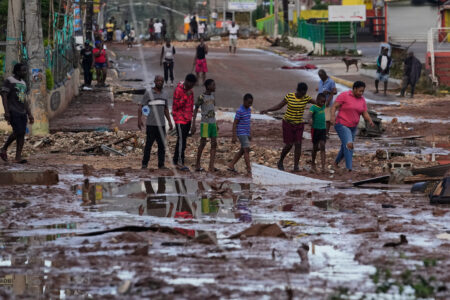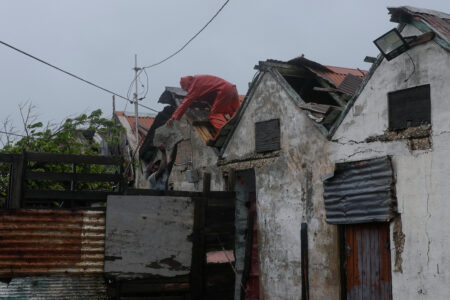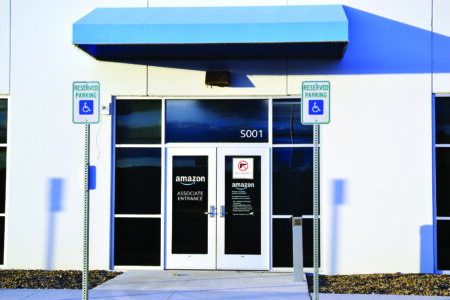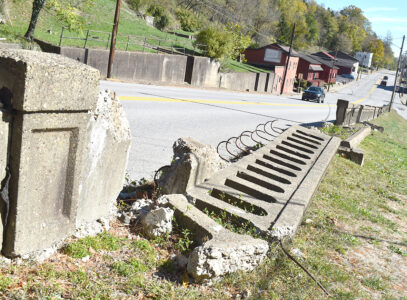1990 SHADYSIDE FLOOD: Grief and Mud Were Everywhere

Two men survey debris that had collected in the Ohio River at the Hannibal Locks and Dam following the Wegee Creek flood in Shadyside on June 14, 1990. File photos by Scott McCloskey
The night of June 14, 1990 was very dark, wet and loud. I remember walking out onto my front porch on GC&P Road in Ohio County. The rain was coming down so hard on the roof that it woke my 5-year-old son. Neighbors began stepping out onto their porches as well. This rain was something so totally out of the norm that it was scary.
The creek across from our house was roaring past with thunderous noise. You could hear trees cracking and unknown things crashing against the retaining wall. Water also was running down the road in torrents strong enough to move a car. I was not worried about water reaching our homes as they sat up off the road along the hillside. Only when I stepped into the side yard did I feel a panic rise in my throat. Water was shooting off the hill between our house and the neighbor’s. It was as if someone opened a fire hose at full pressure as water flew through the air. The side yard had become a swamp.
My husband was working his 24-hour shift at the Wheeling Fire Department. He and the other firefighters had their hands full with flooding issues, too.
A neighbor and I traded concerns: Should we leave and go to higher ground. Would the hillside behind us come down and swallow our homes? We had no way of knowing if the road was washed out beyond our homes so we decided to stay put and ride out the storm.
Later we would see that portions of the road were washed out along the creek, pavement was buckled in places and several neighbors whose garages were down under their homes received hefty amounts of water.
But it was not until the next morning did I realize how bad the storm had been to our neighbors across the river in Belmont County. The ground had been super saturated from days of rain when the June 14 deluge of more than five inches of rain in a short amount of time decimated the Wegee Creek and Pipe Creek area of Shadyside.
The storm destruction was biblical in nature. A wall of water brought instant devastation of homes, vehicles and lives. Reports of people screaming for help in the darkness haunt first responders even today. With daylight came the real picture.
For days we would hear from families searching for missing loved ones. Exhausted safety crews and volunteers were relentless in their efforts to help in rescues, searches and eventually, recoveries. Twenty-six people lost their lives that night in the East Ohio flood. Scores of buildings and vehicles were destroyed, carried away like toys in the raging water.
For the local media, this was the story that would go on for days, weeks, months. Reporters and photographers grew weary with all the sadness, the destruction and the mud. I remember reporters coming back to the newsroom, their boots and clothes mud-spattered.
Their shoulders drooped from the burdens they carried as they did their best to write stories that told of the grief and indescribable terror many residents related to them.
As the days passed, reporters who routinely covered East Ohio for the Wheeling newspapers would filter in and out of the office. They quickly learned the benefit of carrying extra boots and shoes as the mud stayed around for quite some time, as is the case with flooding.
Some of the reporters were eager to share their stories with others in the office while a few just sat quietly, staring at their computer screens, then filing their stories. It was a sensational story that just kept evolving as bodies were uncovered. Grief was everywhere as residents of the Ohio Valley tried their best to help their neighbors. This tragedy, like others in this area, brought out the best in people, too.
Scott McCloskey, an award-winning photographer for this newspaper, saw firsthand the toll the storm had on the people, their communities, government leaders and others.
As news of the devastation spread, the local news media were soon joined by several national news people who descended on the area like bees on honey. For them, it was an opportunity to grab some photos and stick microphones in the faces of people still shell-shocked at the loss of family, friends and their homes.
But for the local news media, these were our neighbors. We knew the names and faces of the fire chiefs and government leaders overwhelmed with the sheer magnitude of the loss. Some of us had family or friends affected. We knew this was going to be hard to cover.
“We (the media) were put in the back of a pickup truck and driven to the area where we would be getting pictures. We were told not to get out of the truck, but as soon as we stopped, the national media jumped out and started interviewing people,” McCloskey recalled.
His instincts kicked in and McCloskey began shooting photos of everything around him. He said it was the worst flood he had ever seen. There were no cellphones or Facebook to instantly tell people what was going on the night of the storm, so it was shocking when he finally saw what had happened.
“I remember seeing this one woman standing there with all this debris around her. I remember she had gloves on her hands … her hands were spread apart and she had this look on her face like ‘where do I start?'”
He said he could not believe that Wegee or Pipe creeks, normally docile streams, could have that much water run through them.
McCloskey said he had no idea what to expect when he was sent to cover the flood.
“I remember Al Molnar saying ‘You need to go over to Shadyside. There are people missing.’ I never realized how bad it was until I went over there. It just hit me.”
He also noticed military helicopters flying over the Ohio Valley and political figures coming into the area. Once again, the Ohio Valley was in the news for a tragic event.






